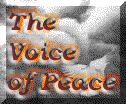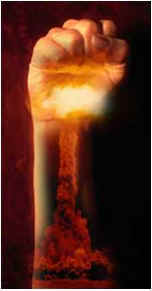THE NUCLEAR TESTS From Hiroshima
to Pokhran
A three-member Japanese delegation visited Pokhran as part of a 10-day tour of India
and Pakistan aimed at raising public awareness about the devastating effects of nuclear
war.
JEAN DREZE
"I WONDER for what purpose she came into this world," said Hiroshima survivor
Yasuhiko Taketa, referring to his elder sister who died in agony at the age of 16. She was
1.4 km away from "ground zero" when a nuclear bomb was dropped on Hiroshima on
August 6, 1945. She was brought home, 7 km from ground zero, the next evening. "Her
arrival is," said Taketa, "a very sad memory for me." "She was lying
on a cart, severely burnt. Her clothes were glued to her skin. We wanted to spread oil on
her skin, but we could not remove her clothes. So we had to cut the clothes away from the
skin with scissors, causing her horrendous pain. She died on August 9, crying 'Mother,
help me, mother help me'. There was nothing we could do to help her. There were no
medicines, no doctors." Thus spoke Yasuhiko Taketa in Pokhran on June 17, 1998. Also
present were two other Japanese citizens: Masa Takubo, international consultant of Japan's
Gensuikin (Congress Against Atomic and Hydrogen Bombs) and Ken Sakamoto, secretary-general
of Gensuikin's Hiroshima branch.
The team's visit to Pokhran was part of a 10-day tour of India and Pakistan aimed at
raising public awareness about the devastating effects of nuclear war.
The people of Pokhran gave a warm reception to the Japanese delegation. When the
visitors arrived around 9.30 p.m., accompanied by a small group of concerned Indian
citizens, hundreds of local people were waiting for them at Gandhi Chowk. They listened
patiently until close to midnight, despite the frustration of double translation (from
Japanese to English and then to Hindi). The audience was deeply moved by the delegation's
testimonies, which included an exhibition of photographs from Hiroshima and a short film.
Taketa's closing plea for a world-wide abolition of nuclear weapons and nuclear tests was
greeted with loud applause.
Taketa spoke with calm and dignity, despite the obvious emotions stirred by memories of
the dreadful events that followed the explosion:
"My name is Yasuhiko Taketa. I come from Hiroshima, where an atomic bomb was
dropped on August 6, 1945, for the first time in history. I was 12 years old at that time,
and a first grader in junior high school. We received a militaristic education and were
told that we should give up our lives for the Emperor and for the country. Japan was
losing its power day by day. By early 1945, it had lost control of the sea as well as of
the sky.
"My home town was outside Hiroshima, but my school was in Hiroshima. On August 6,
1945, we had been given a day off. In the morning, I was asked to deliver some food to my
elder sister's house. A little after 8 a.m., I was waiting for the train at the railway
station. Suddenly, there was an intense flash. Everything looked bluish white. Then there
was a thunder-like sound. I felt as if my stomach had been cut open and my intestines were
coming out. Then I felt extreme heat on my cheek. Looking in the direction from where the
heat was coming, I saw a white spot, which became yellow and then red, and turned into a
huge fireball, seemingly coming towards me. It was a horrendous sight. I felt like
choking. I was looking at this 7 km away from ground zero.
"Later, I learnt that Enola Gay had released the bomb at a height of 9,000 metres,
and that the bomb had exploded at a height of 600 metres. The surface temperature at
ground zero rose to 6,000 oC. The diameter of the fireball was 200 metres. Under the
fireball, those who had not been killed instantly were running around, trying to escape.
After a while, we saw people fleeing Hiroshima towards our town. They looked like ghosts.
Many were burnt, almost naked, with swollen faces, or had their skin peeled by the heat.
Some were holding their intestines.
"Two days after the explosion, I walked into Hiroshima with some friends. The city
was totally destroyed. There were dead bodies everywhere. Our school was devastated. The
second graders who were at school that day were killed, all 183 of them. All around us,
people were still dying. Some were crying, 'Give me water, give me water'. I saw a child
groping for his mother's breast, but she was already dead. There were no facilities for
cremation, so people dug holes and threw the bodies in them and then burnt them. There was
a smell of charred bodies everywhere.
"At that time, Hiroshima's population was 400,000, of which 140,000 died by the
end of 1945, 90 per cent of them within a week of the explosion. Of the city's 76,000
buildings, 70,000 were completely destroyed or burnt down.
"People continue to die even today, from the after-effects of radiation. The
dreadfulness of nuclear war is that even if you survive the bombing, you can suffer much
later. As of last year, there were 202,118 registered deaths due to the Hiroshima bombing.
Survivors are faced with suffering and the fear of death every day. I would like you to
remember this.
"Today's bombs are far more powerful than the bomb that fell on Hiroshima. Imagine
what would happen in the event of a nuclear war between India and Pakistan. Governments
talk of nuclear deterrence, but nuclear weapons cannot bring security. In a nuclear war,
there are no winners. Security comes from peaceful relations between nations.
"I don't know how long I will live, but however long I live, I want to continue
working for peace. I also call on the people of India and Pakistan to work together for
peace. That is my dream. As the Japanese philosopher Ichiro Moritaki said, 'We have to
stop the chain reaction of atoms through the chain reaction of human beings'. Let us work
together for peace, so that we may leave a peaceful world behind us for our children and
grandchildren. That is my plea, and the message I have brought from Hiroshima."
EARLY the next morning, the delegation proceeded to Khetolai village near the test
site. The reception they received there was overwhelming. The villagers had erected a
large shamiana and had prepared a colourful welcome ceremony. In his opening remarks, the
deputy sarpanch reminded the audience that at the time of the creation of the test site in
1965, the village had signed a petition against it. While greeting the Japanese visitors,
he said that he wished they had come earlier, implying that the recent tests may have been
averted.
The villagers watched the exhibition of photographs from Hiroshima with solemn
interest. Already concerned about the possible side-effects of nuclear tests in the area,
they were in total sympathy with the team's mission. Many of them were quick to point out
that the Government should spend its money on schools and health centres, rather than on
nuclear weapons. They felt even more strongly about it after Taketa's speech. As in
Pokhran, his call for world peace and the elimination of nuclear weapons was received with
roaring applause.
At the end of the programme, a local resident drafted a resolution, calling for
universal nuclear disarmament and an immediate end to all nuclear tests. The resolution
also demanded that the Government inform and consult citizens before any use of nuclear
energy. The resolution was unanimously endorsed by a show of hands, and signatures from
those who could sign in the rush that followed.
THE Khetolai declaration and the gatherings that preceded it raise interesting
questions about the popular attitude towards the development of nuclear weapons. According
to a much-cited "opinion survey" that was published in The Times of India
on May 13, 90 per cent of the population approved of the recent tests. This survey was,
however, conducted by telephone in eight major cities and is therefore confined to the
privileged urban classes. The fact that the responses of telephone owners in the major
cities were used to represent the views of the entire population speaks volumes about the
political marginalisation of the underprivileged majority. It may be argued that ordinary
people are not sufficiently aware of the facts to have an informed view on these issues.
This is correct, but the solution to this is to inform them, rather than to rely on others
to represent their views. The Pokhran and Khetolai gatherings show that when people are
adequately informed, their views on nuclear weapons are far less enthusiastic than what
the survey suggests.
That the people of Khetolai should turn out to be strong critics of nuclear weapons and
nuclear testing is not surprising, given their concern about the possible effects of
radiation in the area. More interesting is the public response in Pokhran, a BJP
stronghold, where, according to earlier press reports, the nuclear tests were greeted with
jubilation. The warm reception given to the Japanese delegation in Pokhran is not
inconsistent with the possibility that many local residents consider the recent tests as
being justified. However, the Pokhran gathering brings out another aspect of the public
mood: when presented with the facts, most people strongly support universal nuclear
disarmament and an immediate end to all nuclear tests. It remains to be seen whether the
Government's nuclear strategy will do justice to this overwhelming popular concern. |



